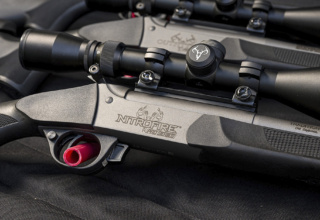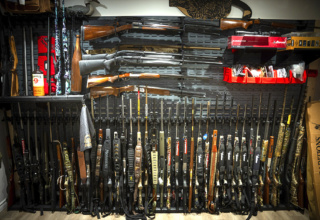If you’ve thought about getting into muzzleloading, you might want to consider building your rifle. There is no better way to become familiar with all the terms and components of a smoke pole than to build it one piece at a time. Seeing how a trigger assembly works with a percussion lock, and where the spark must travel, provides complete insight into how a gun goes “bang.”
Traditions Performance Firearms has “Build-It-Yourself Rifle Kits,” providing all the components to put together your custom rifle from the stock up. There are six models to choose from including percussion models in a Kentucky, Deerhunter, Crockett, Prairie Hawken, Mountain, and St. Louis Hawken. All models are old-style guns with hardwood stocks, steel barrels, and brass components. You build the gun yourself, from sanding and finishing the stock to bluing the barrel. Complete and simple instructions allow you to become a savvy muzzleloader enthusiast, who will understand the principles of loading and ignition.

I’ve always wanted a Kentucky Rifle, with the long, wood stock extending the length of the barrel. Building the gun was a fun project that took a couple of evenings, but has generated new goals for me to harvest a deer with the rifle I built. Some skill is required for finishing the wood and fitting parts together carefully, but overall it is a great project even for someone with little or no carpentry or gunsmithing skills.
Here’s how it happened
Everything needed to make a working gun comes in a single package. Once opened, it’s easy to inventory parts and store them in containers until they are needed at specific stages of the build. After going through the entire gun and making everything fit properly together, I started finishing the stock. The stock was rough cut and needed to be finished with a medium grit paper, followed by fine. There are companies that offer gun stock finishing kits, which make it easy with step-by-step instructions, however, I opted to purchase a wood stain and do it all myself.
 Before the stain was applied, I fit the components together dry, and set it up so I wouldn’t have to sand finished wood.
Before the stain was applied, I fit the components together dry, and set it up so I wouldn’t have to sand finished wood.
The stain was applied in small amounts with a rag and worked into the wood. I tested the color first on a separate piece of wood to ensure I liked it and could work the stain evenly. Two coats of stain in a Gunstock shade provided adequate protection, and the stock was finished with polyurethane for a protective finish.
The barrel needs to be treated with bluing or browning, and Birchwood Casey makes an easy-to-use kit for finishing the metal. I opted for bluing and found it easy to apply with a sponge. When complete, a quality gun oil is applied to the barrel to maintain the finish.
 Every kit is different, and the instructions indicate the Kentucky rifle requires an intermediate skill level, meaning you should expect to do some filing of both metal and wood to make them fit together properly. Making everything fit together is all part of the learning experience.
Every kit is different, and the instructions indicate the Kentucky rifle requires an intermediate skill level, meaning you should expect to do some filing of both metal and wood to make them fit together properly. Making everything fit together is all part of the learning experience.
The kits are very comprehensive and provide detailed instructions that are easy to follow. The most difficult part of building your rifle is stopping between steps. Once you get started, you’ll want to move directly to the next. Seeing each part and knowing how they fit together, and work provides a complete understanding about muzzleloading and what is required to make a gun go bang.

















